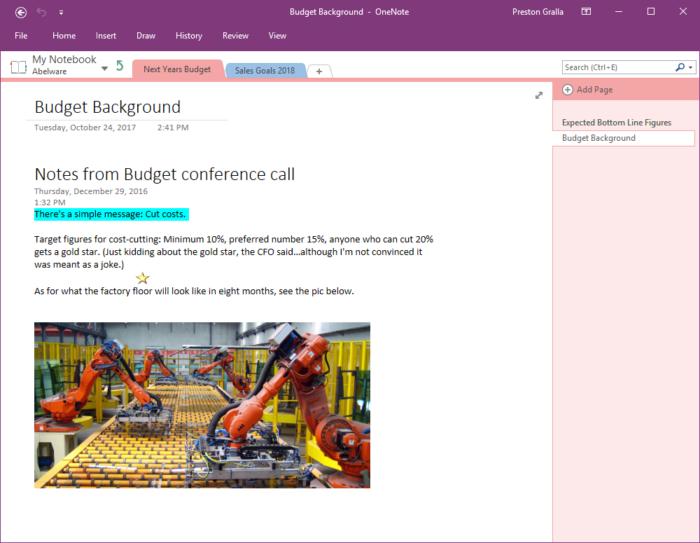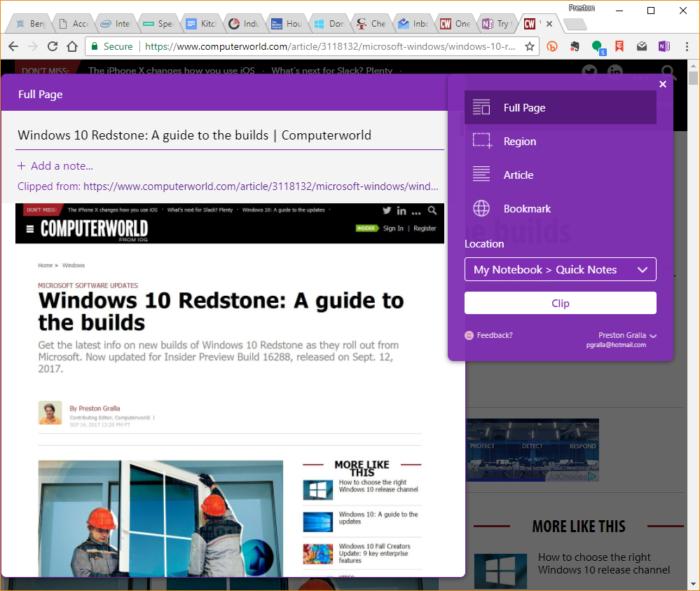OneNote vs. Evernote: A personal take on two great note-taking apps
What’s the king of the note-taking apps?
Is it Microsoft OneNote, launched in 2003, added to Microsoft Office starting in 2007 (and thus available to more than 1.2 billion users) and now offered for free as a standalone product? Or is it the independent Evernote, which launched back in 2008 and is estimated to have somewhere in the range of 200 million users by now?
OneNote and Evernote are available for all the major desktop and mobile OSes, they each sync your notes to all of your devices and the web, and both promise to be the only note-taking app you need. But they also have some very distinct differences. So which is better?
I'm a longtime user of both applications, so I've taken a look at the latest version of each for Windows, macOS, iPad, iPhone and Android. This isn't a deep-dive review, but rather a personal look at what I like and don't much like about each — and the main points of difference between the two. I spend more time on the Windows version of each, but note similarities and differences in other versions as well.
OneNote: A great way to get organized
OneNote is very much a full-blown application. It lets you create simple or complex notes from scratch, organize them into searchable, browsable notebooks, and sync them among a variety of platforms, including Windows PCs, Macs, iPads and iPhones, Windows Phones, Android devices and the web.
It bristles with note-creation tools for drawing, recording audio and video, scanning images, embedding spreadsheets and reviewing the edits of others (although the abilities of those tools differ somewhat depending on the platform). In fact, its note-creation tools are more comprehensive than Evernote's.
The organization-minded will appreciate OneNote's basic structure. You create individual notebooks; within each notebook, you can create section groups that contain multiple sections. Each section has individual pages, with each page a separate note. It's ideal for organizing content with a logical structure.
For example, if you’re using OneNote to keep track of notes about your sales staff, you could have a Sales Staff notebook, then section groups for each salesperson, and within each of those section groups there might be sections for each of their customers. Within each of those customer sections, you could have individual pages, with notes about the salesperson’s relationship with them, and include links to sales figures.
Clipping notes
As good as OneNote is at creating notes, it falls short of Evernote's considerable capabilities for clipping content from the web.
OneNote offers browser add-ons for Microsoft Edge, Internet Explorer, Chrome, Safari and Firefox. The interface is generally the same for all of them. When you're on a web page from which you want to clip content, click the OneNote web clipper icon in the browser’s toolbar and you can choose to clip the entire page, a section of the page, or just the article in a simple-to-read format without ads and other distractions. You can also save the page as a bookmark. (Note: In Safari, right-click on the page you want to clip and select “OneNote web clipper” from the menu that appears.) Once you decide the kind of clip you want, you can save it directly to any OneNote notebook.
All that is well and good, but there’s a serious drawback to how OneNote captures web content: The clip is a graphic image only, so that any links or multimedia elements on the page don't work. You also can’t copy and paste content from the saved page into another application like Word. Finally, you can only use the web clipper if you have a Microsoft account.
The differences among versions
It's in Windows where OneNote really shines, because that's where it has its full complement of note-creation tools. It's also where its heritage as an Office application is clearest, because it uses the Office Ribbon as a way to give you access to all of its features.
OneNote for Windows has seven Ribbon tabs — File, Home, Insert, Draw, History, Review and View — each of which gives you access to plenty of features. The File tab (also sometimes called Backstage) is similar to the File tab in other Office applications, and lets you open, print, share and export files; change settings; and more. The Home tab lets you format text, add tags, mark items as important and more. The Insert tab offers tools for inserting objects into your notes, including spreadsheets, pictures, audio and video you can record, equations and symbols.
The Draw tab has the usual drawing tools, while History lets you collaborate with others, so that you can find other users' recent edits and comments, and so on. Review includes familiar Office features including a spell checker, a thesaurus and a translation tool. And View has plenty of ways to change the appearance of your notebooks and their pages, such as adding lines, changing their size, changing the colors and so on. Evernote has nothing approaching any of these sophisticated tools.
Each page you create is a blank slate that lets you add text, images, media and objects in a freeform way, moving them around and formatting them with ease. For those who want to spend the time, it can mean creating extremely rich pages. But if all you want is text, that's simple to do as well.
The iPad and Mac versions have the same basic look, feel and organization as the Windows version, although with fewer features. (The Mac version has more capabilities than does the iPad version.) They have four tabs across the top, rather than six: Home, Insert, Draw and View.
In some instances the tabs are as fully featured as in the Windows version — the Mac's Home tab, for example, includes all of the formatting and other capabilities of the Windows version. (The iPad doesn’t have as many capabilities.) Other tabs have far fewer features — notably the Insert tab. There, the Mac version only allows you to insert basics such as tables, pictures, links, attachments and the date and time, not the wide range of objects and content you can work with in the Windows version. The iPad has similar drawbacks, although it does let you take a photo with the iPad’s built-in camera and insert it.
The web version of OneNote features the tabbed design of the Windows, Mac and iPad versions, with the same basic feature set as the Mac and iPad versions.
The iPhone interface is much simpler than on Windows, the Mac or the iPad. You see your section groups in a scrollable list, and can then navigate easily down into individual sections and pages. It doesn't have tabs, given the iPhone's limited screen real estate, and it's built mainly for quick-and-dirty note taking or checking your existing notes.
The Android version looks and works much like the iPad version, with Home, Insert, Draw and View tabs, although it’s not as fully featured. For example, the Insert tab only lets you insert pictures, audio, to-do items, tags and links.
Storage options
OneNote syncs its content among all of your devices and to the web via Microsoft OneDrive. If you buy the non-subscription version of Office, you get up to 5GB of cloud storage space for everything including your OneNote content, although you can buy additional storage space. If you buy an Office 365 subscription, you get much more storage — 1TB to 5TB, depending on the version you buy.








No comments: